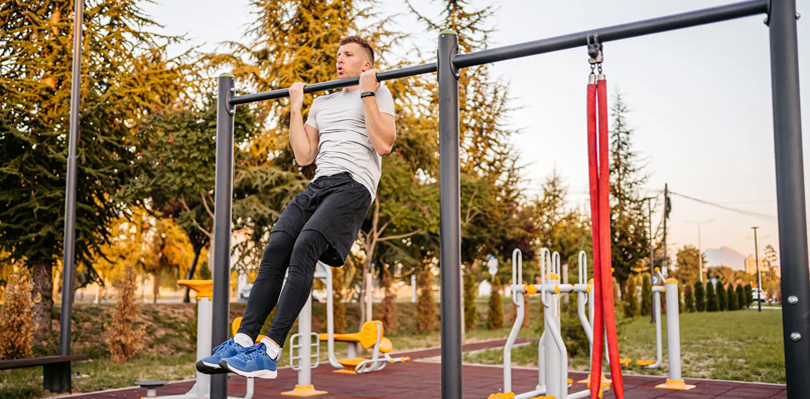Are you ready to elevate your fitness routine and conquer the coveted realm of pull ups? Whether you’re a seasoned athlete looking to enhance your upper body strength or a beginner eager to embark on a transformative fitness journey, you’ve come to the right place. In this comprehensive guide, we’ll unravel the secrets behind one of the most effective and versatile bodyweight exercises – pull ups.
Prepare to be amazed by the multitude of benefits that pull ups can offer, from sculpting a chiseled upper body to boosting your overall health and functional fitness. We’ll dive deep into the mechanics of pull up execution, providing you with step-by-step instructions and pro tips to ensure you master this exercise with confidence. Say goodbye to excuses and hello to a stronger, healthier you. So, let’s pull together the knowledge, the strength, and the motivation you need to master pull ups and unlock a world of fitness possibilities!
How To Do Pull Ups

Pull Ups are a fantastic exercise for strengthening your upper body, particularly your back, shoulders, and arms. Here’s a guide on how to do pull-ups properly:
Find A Suitable Pull Up Bar
Start by locating a sturdy horizontal bar that can support your body weight. This could be a pull up bar at the gym, a doorframe pull-up bar, or even a secure horizontal beam if you’re outdoors.
Proper Grip
Stand in front of the bar and reach up to grasp it with your palms facing away from you (overhand grip). Your hands should be slightly wider than shoulder-width apart. Ensure your grip is firm.
Hang From The Bar
Jump up or use a step to help you reach the bar. Hang from the bar with your arms fully extended, and your body should be straight, not swinging. This is your starting position.
Engage Your Core
Tighten your core muscles to stabilize your body. This will help maintain a straight line from your head to your heels.
Pull Yourself Up
Initiate the pull up by squeezing your shoulder blades together and bending your elbows. Focus on pulling your chest toward the bar. Keep your body straight throughout the movement, avoiding any swinging or kicking.
Chin Above The Bar
Continue pulling until your chin clears the bar. This is the top of the pull up position. Your elbows should be pointing down at this point.
Lower Yourself Down
Slowly lower yourself back to the starting position by extending your arms fully. Maintain control throughout the descent.
Repeat
Perform the desired number of repetitions. Beginners may start with 3-5 reps and gradually increase as they get stronger.
Remember, consistency is key when learning how to do pull ups. With practice and dedication, you’ll improve your strength and be able to perform this challenging exercise with ease.
Benefits Of Pull Ups
Pull ups are a highly effective bodyweight exercise that offers numerous benefits for your overall fitness and strength. Here are some benefits of including pull ups in your workout routine:
Improved Upper Body Strength
Pull ups primarily target the muscles in your upper body, including the latissimus dorsi (lats), biceps, triceps, deltoids, and the muscles of your upper back. Regularly incorporating pull ups into your workouts can significantly increase your upper body strength, leading to improved muscle definition and functional strength.
Enhanced Grip Strength
Pull ups demand a strong grip to hold onto the bar, and as you progress, your grip strength will naturally improve. Strong grip strength is beneficial not only for other exercises but also for everyday activities like carrying groceries or opening jars.
Back Development
Pull ups are renowned for their ability to build a well-defined and strong back. They target the lats, which, when properly developed, contribute to the highly sought-after V-shaped physique. A strong back also promotes better posture and reduces the risk of back pain.
Core Engagement
To perform a pull up effectively, you need to engage your core muscles to stabilize your body. This helps strengthen your abdominal muscles and obliques, contributing to improved overall core strength and stability.
Versatility
Pull ups can be adapted to various grip positions, such as wide grip, close grip, or neutral grip. Each grip targets slightly different muscle groups, allowing you to customize your workouts to target specific areas of your upper body.
Functional Fitness
Pull ups are a compound exercise, meaning they involve multiple muscle groups working together. This mimics real-world movements and enhances your functional fitness, making daily activities easier and reducing the risk of injury.
To reap these benefits, it’s important to incorporate pull ups into your fitness routine consistently. Whether you’re a beginner using assistance or an advanced athlete adding weights to your pull-up routine, this exercise can be tailored to suit your fitness level and goals.
Pull Ups Exercises
Here are some variations of pull up exercises, each targeting specific muscle groups and providing unique challenges to help you diversify your workout routine:
Wide-Grip Pull Ups
- Muscles Targeted: Primarily the latissimus dorsi (lats), teres major, and biceps.
- Execution: Grab the pull-up bar with your hands placed wider than shoulder-width apart. Perform them with this wider grip to emphasize the development of the outer lats. This variation can help create a broader back appearance.
Close-Grip Pull Ups (Chin-Ups)
- Muscles Targeted: Focuses on the biceps, lower lats, and middle back.
- Execution: Place your hands on the pull-up bar closer together, with your palms facing you (chin-up grip). Chin-ups are a great variation for building arm strength and developing the “peak” of your biceps.
Commando Pull Ups
- Muscles Targeted: Engages the biceps, lats, and forearms, with an emphasis on the brachialis (a muscle underneath the biceps).
- Execution: Start with a standard pull-up grip, then slide one hand closer to the center of the bar and the other hand wider. Alternate your hand positions on each rep. This exercise provides a unique challenge and works on muscle imbalances.
Behind-The-Neck Pull Ups
- Muscles Targeted: Primarily focuses on the rear deltoids and upper traps.
- Execution: Reach up and grab the pull-up bar with a wider grip. Instead of pulling to the chest, pull yourself up and try to touch the back of your neck to the bar. Be cautious with this variation as it can put additional stress on the shoulder joints, and it may not be suitable for everyone.
L-Sit Pull Ups
- Muscles Targeted: Engages the entire upper body, particularly the core, lats, and shoulders.
- Execution: Begin by hanging from the bar and then lift your legs straight out in front of you to form an L-shape with your body. Maintain this position while performing them. L-sit pull-ups challenge your core stability and enhance overall strength.
Muscle-Ups
- Muscles Targeted: Involves a combination of a pull-up and a dip, engaging the lats, chest, triceps, and shoulders.
- Execution: Start with a false grip (wrists above the bar), pull yourself up as in a regular pull-up, and then transition into a dip at the top to get your body over the bar. Muscle-ups require significant upper body strength and coordination and are considered an advanced variation of the pull-up.
When incorporating these pull-up variations into your workout routine, ensure you maintain proper form and gradually increase the difficulty as you progress. These exercises not only add variety but also target different muscle groups, helping you achieve a well-rounded upper body strength and development.
Tips And Techniques To Do Pull Ups
Mastering pull-ups can be challenging, but with the right techniques and tips, you can progress steadily. Here are a few tips and techniques to help you improve your pull-up performance:
Proper Form Is Key
Technique: Start by hanging from the bar with your arms fully extended and your body straight. Avoid swinging or using momentum to pull yourself up. Initiate the movement by squeezing your shoulder blades together, then pull your chest towards the bar. Keep your elbows pointing down.
Tip: Maintaining strict form ensures you’re effectively targeting the right muscles and preventing injury. Focus on quality reps over quantity.
Engage Your Core
Technique: Tighten your core muscles throughout the entire pull-up motion. Imagine pulling your belly button towards your spine to stabilize your body.
Tip: A strong core helps maintain a straight body position, reducing the likelihood of swinging and making pull-ups more challenging.
Control the Descent (Eccentric Phase)
Technique: After reaching the top of the pull-up, lower yourself down slowly and with control. This is called the eccentric phase or negative pull-up. Make it a goal to take at least 2-3 seconds to lower yourself.
Tip: The eccentric phase builds strength and muscle control, which can help you perform more reps in the future. It also reduces the risk of injury compared to dropping quickly.
Use Assisted Pull Up Methods
Technique: If you can’t yet perform unassisted pull-ups, use resistance bands or a pull-up assist machine at the gym. These tools reduce the amount of body weight you need to lift, making the exercise more manageable.
Tip: Gradually decrease the assistance over time as you get stronger until you can perform unassisted pull-ups. This progressive approach helps build strength.
Vary Your Grip and Hand Placement
Technique: Experiment with different grip positions, such as wide grip, close grip, or neutral grip (palms facing each other). Each grip targets slightly different muscles. Additionally, try changing your hand placement by going wider or narrower on the bar.
Tip: Varying your grip challenges your muscles in new ways, preventing plateaus and promoting overall upper-body development.
Incorporating these techniques and tips into your pull up training will help you build the strength and skill necessary to perform this challenging exercise effectively. Remember that progress varies from person to person, so stay committed and keep working towards your pull-up goals.
FAQs
Are pull ups suitable for beginners?
It can be challenging for beginners, especially if you lack upper body strength. However, they are a valuable exercise for building strength. Beginners can start with assisted pull-ups using resistance bands or an assist machine at the gym. Alternatively, you can work on building foundational strength with exercises like lat pulldowns, inverted rows, and negative pull-ups (focusing on the lowering phase). As your strength improves, you can gradually progress to unassisted pull-ups.
What are the common mistakes to avoid when doing pull-ups?
Common mistakes when doing pull ups include using momentum to swing your body, not engaging your core, and not achieving the full range of motion. It’s important to maintain proper form, avoid excessive swinging, and perform each rep with control. Ensure that you fully extend your arms at the bottom and aim to bring your chest to the bar on each pull-up. Additionally, not warming up adequately or progressing too quickly in terms of difficulty can lead to injury.
How can I increase the number of pull ups I can do?
To increase the number of pull ups you can do, follow a progressive training program. Start with a manageable number of reps and gradually increase them over time. Include both pull up variations (e.g., wide grip, close grip) and auxiliary exercises (e.g., lat pulldowns, bicep curls, inverted rows) in your training routine to strengthen the relevant muscle groups. Performing negative pull ups, where you focus on the lowering phase, can also help build strength. Consistency, proper nutrition, and adequate rest are essential for progress.

